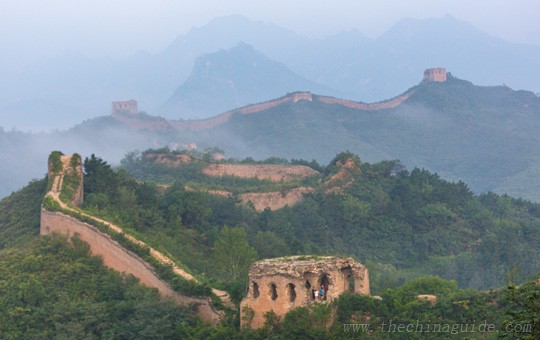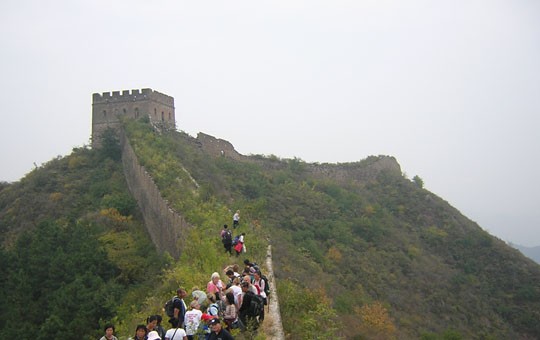Gubeikou Great Wall

The Gubeikou section of the Great Wall is a bit over two hours' drive outside Beijing and is connected to the Jinshanling section. Unlike Jinshanling, Mutianyu, and Badaling, where part of the Great Wall has been restored to a picture-perfect and safe state, Gubeikou Great Wall remains completely in its original condition.
The Great Wall at Gubeikou is crumbling, much of it has no safety edges, and there is a lot of loose rock. That said, Gubeikou offers unique insight into the history of the Wall and outstanding views of its original, unrestored state, making it great for those who are accustomed to hiking in wild areas.
Highlights and Travel Tips
Gubeikou, which means "ancient northern pass" in Chinese, functioned as the north gate of Beijing and thus has important military significance. This part of the Great Wall has been the site of more than 100 battles throughout history, the most recent one being the Defense of the Great Wall, a campaign between the armies of the Republic of China and Empire of Japan in 1933. Today, when you stroll along the Gubeikou section, you can still see the marks of war on the Great Wall.
Like much of the Great Wall near Beijing, the Gubeikou section was originally constructed in the 6th century and then rebuilt in its current state during the Ming Dynasty (around 1567). No rebuilding or renovation has been done to this part of the Wall since then, so what you see at Gubeikou are real remnants of the Ming Dynasty.
The Gubeikou section of the Wall is around 10 km long, and is split roughly in half into two segments: the western end is known as Wohushan, and the eastern part is called Panlongshan. Because of its wild state, Gubeikou draws far fewer visitors than restored sections of the Wall closer to Beijing and most visitors come for a hike on the wild Great Wall.
Gubeikou Great Wall is not a fenced-in scenic area, which means you can get to the Wall anytime and at any place. However, you still need to buy a ticket to access this section, because there are sometimes staff on the Wall during the day checking if visitors have a ticket. There is no need to buy tickets in advance though; if a staff member approaches you and you don't have ticket, you can just pay them to receive a ticket.
Hiking and Camping

The popular hiking route starts from the west end of Panlongshan Great Wall and ends at the famous 24-eye Watchtower, the east end of Panlongshan section. This route is about 5 kilometers long and takes about 2.5 hours. For people who want to hike all the way to Jinshanling Great Wall, they need to make a detour away from the Great Wall at the 24-eye Watchtower to bypass a prohibited military zone and then get back on the Great Wall and continue hiking to Jinshanling. If you cannot speak Chinese and are unable to ask for directions along the way, we highly recommend you go with a guide, since the detour winds through fields and villages.
The entire hiking route from Gubeikou to Jinshanling is about 14 kilometers long and takes around 5-6 hours. This route is not difficult but the long distance makes it more suitable for keen hikers.
Along the hike there are many loose bricks where parts of the Wall have collapsed, so wear comfortable walking shoes with good grip. Be sure to wear a hat and/or apply sunblock since there is no shade on the Wall. Bring along some snacks and water since the hike will last a few hours and you won't find vendors on the Wall to top up if you run out of water. There are no restrooms along the Wall.
If you want to spend a night on the Great Wall (weather permitting), we can take you to a well-preserved watchtower at Gubeikou Great Wall. You will be able to wake up, enjoy the sunrise, and have a simple breakfast on the Great Wall, making for an unforgettable experience. Sleeping bags, mats, and tents are provided.
Opening Hours and Ticket Prices
Opening hours: all day
Entrance fee: CNY 45
Average time for this activity: 1 day
How to Get There
There is no direct transportation from Beijing to Gubeikou Village (the closest town to this section of the Wall). While it's possible to get there via a variety of bus routes, we recommend hiring a private car or joining a private tour.
Popular Tours
- Beijing and the Great Wall in One Day
- Jinshanling Great Wall Hike
- Beijing Highlights and Sleep on the Wall
- 3-Day Beijing tour
- Golden Triangle of China - 9-Day Beijing, Xi'an, Shanghai tour
- More Great Wall tours...
